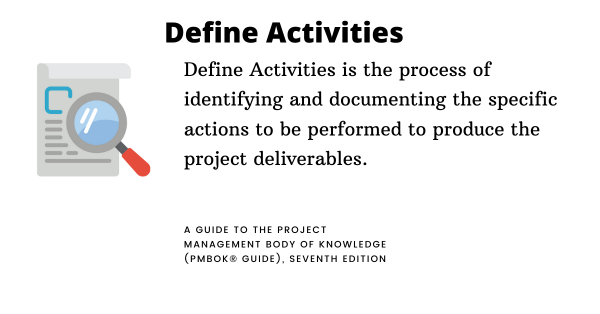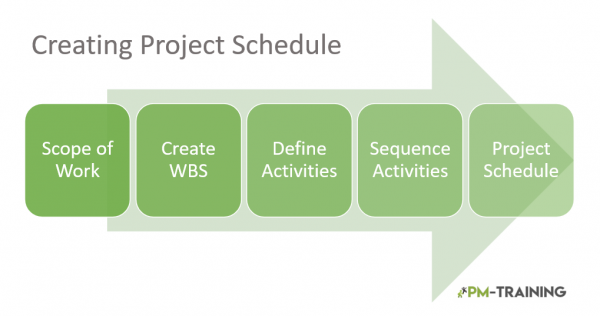In project management, an activity refers to a set of tasks that needs to be carried out to convert inputs to outputs. Define activities, therefore, refers to the identification and documentation of tasks that need to be carried out to achieve project deliverables.
To do that, project managers need to break down a project’s big work packages into small sets of tasks and assign teams to carry out these tasks. The smaller activities from the big work packages make it easier for managers to estimate time and costs, create schedules, implement plans, monitor project progress, and gain better control of the project.
There are two techniques to define activities via decomposition planning or rolling wave planning.
Define Activities Project Management Definition

Define Activities is the process of identifying and documenting the specific actions to be performed to produce the project deliverables. The key benefit of this process is that it decomposes work packages into schedule activities that provide a basis for estimating, scheduling, executing, monitoring, and controlling the project work. This process is performed throughout the project.
PMVBOK 6.2
Define Activities Tools & Techniques
Decomposition Planning
Decomposition is when the team would break down all the work to an activity level so the entire project could be scheduled. This activities have little unknowns such as in traditional projects like construction and civil. Decomposition makes it possible for project managers to estimate the time and cost of completing each project deliverable. For project managers, it is easier to estimate parts of a project than to estimate the entire project. For instance, it is easier and more accurate to estimate the cost of running an acceptance software test than to estimate the cost of creating several software packages for three telecom companies.
With project decomposition, managers are able to direct their teams better and monitor the progress of each step of the project. Managers are able to create detailed instructions on the effective completion of specific tasks. Managers are also able to keep track of any issues and risks that may come along the way.
Rolling Wave Planning
In projects where there are expected unknowns you can use rolling wave planning technique. These is common place in agile project management. Rolling wave project planning focuses on frequent updates and changes to the plans set for a project. The strategy realizes that a project may not offer all the necessary details needed to create a plan upfront. Although the project starts with a plan, the project manager fills the work breakdown structure based on their current knowledge. As more details roll out, the plan evolves. You will be placing new pieces of data into the plan, which can change the activities and other details of the plan.
You can use the rolling wave project management when dealing with a project with a lot of uncertainty. If there are any risks associated with the project, the manager will plan for such risks and have ways to resolve any issues that might come up before they turn into unmanageable problems. Managers can also identify key details of a project scope before they start executing any plans.

Define Activities Project Management
Project managers define activities from work packages. These work packages are items set out in a project’s work breakdown structure (WBS). A WBS is a tool in project management where a manager takes a step-by-step approach to handling large projects. With a WBS, the manager divides a project into small components. Each of these components can integrate scope, cost, and project deliverables. The components of a WBS form the work packages that are then broken down into activities.
With WBS, the manager organizes the total scope of a project in hierarchies. Each level of the hierarchy shows a more detailed definition of the project work compared to the level above it.
The bite-size components of WBS provide a roadmap for the teams handling a project when they are further broken down into activities. The project manager will distinguish activities that need to be carried out with a specific objective and within a specified period to give out project deliverables. A manager needs to show all the details of the tasks and an estimate of the resources and time needed for each of the tasks.
Managers create a project activity list that shows activity identifiers with a description for each scope of work in detail. This ensures that each team member understands what needs to be done.
Define Activities Process
Defining activities project management is part of the overall project plan. A project manager will need to carry out several activities before the plan and after the plan. These activities include:
- Develop project management plan
- Plan scope management
- Collect all the requirements
- Define the scope of work
- Create the work breakdown structure using WBS dictionary
- Plan schedule management
The above activities will act as a guide to the project manager when they are breaking down the scope into small manageable tasks. A project manager will collect all the data needed to create the best project breakdown and set milestones and later the activity list.
An activity list sets out the following:
- Creating a sequence of activities
- Estimating the activity resources
- Estimating the duration for each activity
- Developing a schedule of activities
- Plan cost management
- Estimating the costs
- Determining a budget
After creating an activity list, the project manager needs to ensure that the teams are ready and that each activity is executed and implemented the way it is supposed to be.
Example of Defining Activities
You can apply this project management tool in different projects. For instance, in software development, the project manager can set out the WBS to include the following components:
- Information gathering and analysis
- Design
- Coding and implementation
- Testing
- Deployment
- Maintenance
- Scheduling and resource management
The project manager further breaks down these components of the WBS into activities or sets of tasks that help deliver on the set milestones for each of the above components. For the first component, collection of data, the manager can set out teams for collection, analysis, and interpretations of data on the needs of the people the project targets. Another team can be in charge of features to be added to the project while another can be in charge of how the product will be used when it is complete.
During design, the manager can set teams for component analysis, system design, requirements modification, and development and integration. These teams work together in their various roles to create the app. Teams can also work on the various features of the products where when one team works on the graphics, another one works on the content to be in the software.
For each of the other steps, the manager identifies activities to be performed and assigns teams. While some people test for software integration, others test functionality, other performance, regression, unit, stress, usability, and acceptance. This way, each team has a task to handle and the manager is able to keep track of the progress of the WBS components and the entire project.
Define Activities FAQs
What is define activities in project time management?
It is the process of breaking down a project into small manageable activities that help towards achieving project deliverables. These small tasks are easy to assign and track.
What is the activity definition process?
The process involves decomposition, which is the breakdown of the scope, setting of activity sequence, setting the budget, identify materials, and implementation. Each step is documented as the process rolls out.
What is the purpose of defining activities?
It makes a project easy to manage and easy to create resources, manpower, and materials budget. The process also allows project managers to track the progress of a project with ease.
What is the main objective of Define Activities process?
Defining activities aims at decomposing work packages or milestones into small scheduled activities that offer a good basis for estimating, scheduling monitoring, executing, and controlling a project. Each of the actions is documented to make it easier for the project manager to produce the project deliverables.
What are the outputs of Define Activities process?
The outputs include activity list, activity attributes, and milestone list. These outputs come from inputs, such as scope baseline, schedule management plan, enterprise environmental factors monitoring, and organizational process assets
